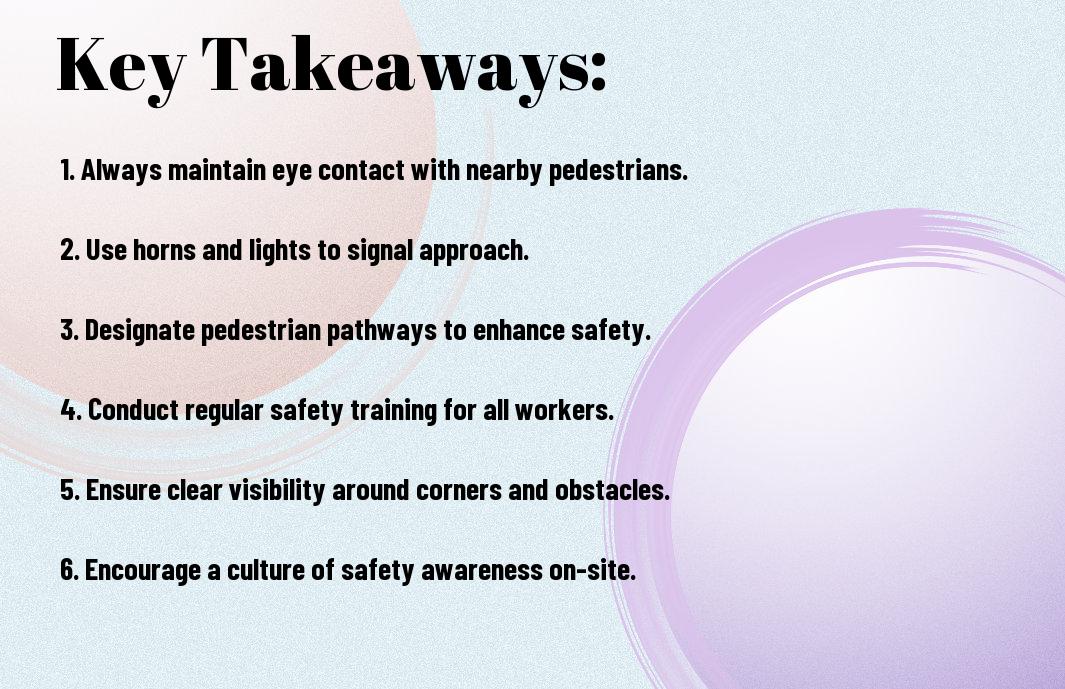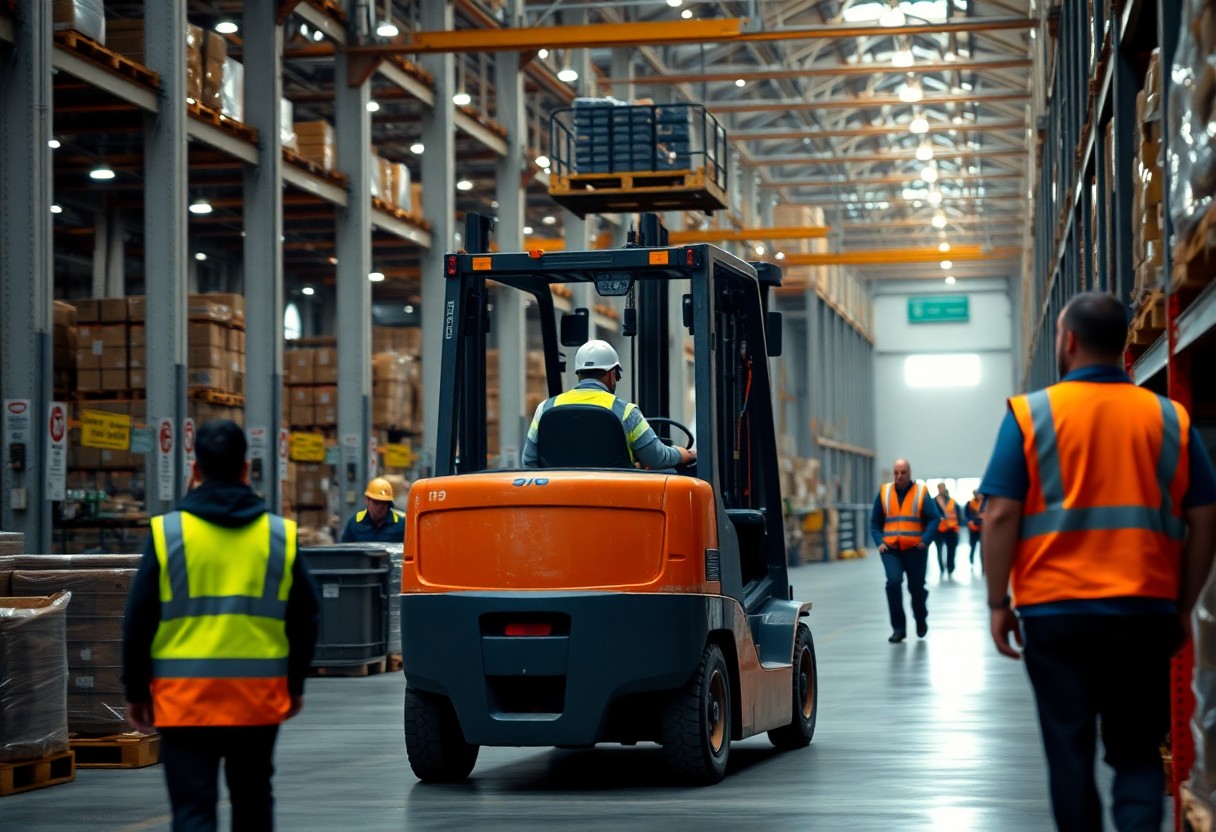Safety is paramount in any workplace where forklifts operate, particularly when it comes to pedestrian interactions. As a forklift operator, it is your responsibility to stay vigilant and actively watch for pedestrians in your vicinity. Poor visibility and limited maneuverability can lead to serious accidents, so always be mindful of your surroundings and establish clear communication with your coworkers. By enhancing your awareness and following established safety protocols, you can contribute to a safer environment for everyone on site.
Key Takeaways:
- Always maintain a clear line of sight when operating a forklift to avoid collisions with pedestrians.
- Establish and follow designated walking paths for pedestrians to minimize interaction with forklift traffic.
- Utilize horn signals and lights on forklifts to alert nearby pedestrians of their presence and to promote safety awareness.

Understanding Forklift Operations
While forklifts are imperative tools in various industries, understanding their operations is vital for maintaining safety in the workplace. Proper training and adherence to operational guidelines ensure that both operators and pedestrians remain safe. Knowledge of forklift mechanics, load handling, and operational signals can minimize accidents and enhance productivity in your facility.
Types of Forklifts
After reviewing the different types of forklifts, you should be familiar with their characteristics and functions:
| Counterbalance Forklifts | Designed with weight at the back to balance loads. |
| Reach Forklifts | Capable of extending their forks to retrieve pallets in narrow aisles. |
| Pallet Jacks | Ideal for transporting pallets over short distances. |
| All-Terrain Forklifts | Specialized for outdoor environments with rugged terrain. |
| Order Pickers | Designed for high-level picking tasks in warehouses. |
The types of forklifts mentioned significantly influence your working environment and operations.
Common Forklift Hazards
By recognizing common forklift hazards, you can take measures to prevent accidents in the workplace. These include operating on uneven ground, poor visibility, and not adhering to manufacturer’s guidelines.
And understanding common forklift hazards is imperative for safety. One of the most dangerous situations arises from collisions with pedestrians, often caused by poor visibility or lack of communication. Additionally, operators must be aware of the risks involved with overloading and tipping, which can lead to serious accidents. Regular maintenance and use of proper safety gear can also help you ensure a safer environment for everyone in your facility.
Importance of Pedestrian Awareness
Some may underestimate the significance of pedestrian awareness in environments where forklifts operate. It’s necessary to recognize that maintaining a safe coexistence between pedestrians and forklifts can greatly reduce the risk of accidents. By understanding the dynamics of your workplace and staying vigilant, you contribute to a safer work environment for everyone. Your awareness of surroundings can be a life-saving habit that promotes safety on the job.
Identifying Pedestrian Zones
Along with understanding the risks, it is necessary to identify designated pedestrian zones within your workplace. These zones should be clearly marked and separate from forklift traffic areas. You should always stick to these marked paths to minimize your chances of encountering moving forklifts and ensure a safer journey around the facility.
Safety Signs and Signals
Awareness of safety signs and signals is vital in promoting a safe working environment. These indicators play a critical role in guiding both forklift operators and pedestrians. You need to heed these warnings and instructions to effectively prevent accidents and ensure everyone’s safety on the premises.
Due to the high volume of pedestrian and forklift interactions, clear safety signs and signals are necessary to convey important information regarding forklift traffic. It’s imperative that you adhere to stop signs, caution signs, and designated crossing signals. These indicators help create a predictable environment, allowing both forklift operators and pedestrians to navigate safely. In high-traffic areas, brightly colored warnings can catch your attention and remind you to stay alert. By being proactive and attentive to these signals, you enhance safety for yourself and your colleagues throughout the workspace.
Best Practices for Forklift Operators
Keep safety at the forefront by always adhering to established protocols, implementing a structured communication system, and ensuring you have adequate training. Stay vigilant to your surroundings, maintain a clear line of sight, and never operate a forklift while distracted. Prioritize the safety of both yourself and pedestrians by being mindful of high-traffic areas and using designated pathways.
Conducting Safety Inspections
After every shift, conduct thorough inspections of your forklift. Check the operational aspects, including brakes, lights, and steering, to ensure everything is in working order. Identifying potential issues early can help prevent accidents and equipment failures.
Using Mirrors and Cameras
With the use of mirrors and cameras, you can significantly enhance your visibility and situational awareness while operating a forklift. These tools help you monitor any surrounding pedestrians and obstacles, ensuring a safer environment.
At the same time, effective use of mirrors and cameras allows you to minimize blind spots, giving you a clearer perspective of the area around you. This can be particularly beneficial in busy environments, where unsuspecting pedestrians may suddenly cross your path. Investing in high-quality mirrors and camera systems can ultimately enhance your ability to avoid accidents, thus ensuring a safer workplace for everyone involved.
Best Practices for Pedestrians
Unlike the controlled environment of a vehicle, pedestrians must always remain vigilant in areas where forklifts operate. You should make it a habit to be aware of your surroundings, ensuring that you maintain a safe distance from machinery and operators. Avoid distractions such as your mobile phone, and always stay alert for approaching forklifts, as they can move quickly and silently.
Right of Way Rules
Right of way rules are crucial for maintaining safety around forklifts. You must understand that vehicles are often limited in visibility, so you should take the initiative to yield to forklifts when necessary. Always follow designated paths, and avoid sudden movements that could confuse operators.
Safe Walking Paths
Along with following right of way rules, you need to stick to marked pedestrian pathways when moving through areas where forklifts are active. These paths are designed to keep you safe and minimize encounters with heavy machinery.
Also, prioritize using clearly marked walking paths that separate pedestrian traffic from forklift operations. Do not cut through or block aisles meant for forklifts, as this increases the risk of accidents. Pay attention to any signage indicating pedestrian zones and stay alert for any changes in the surrounding environment, such as temporary obstacles or machinery being repositioned. Your awareness of walking paths will keep you safer and help others maintain a safer workplace.
Training and Education
Not investing in proper training and education for both forklift operators and pedestrians can lead to serious accidents. Ensure that you are well-informed by checking out 28 Forklift Safety Tips for Operators, Pedestrians, and …, which provides comprehensive guidelines to enhance safety in your workplace.
Forklift Operator Training Programs
Between theoretical knowledge and hands-on practice, effective forklift operator training programs are designed to ensure that you can operate safely and efficiently. These programs cover necessary topics such as load handling, stability, and safety measures that can help you avoid accidents while on the job.
Pedestrian Safety Training
For anyone working alongside forklifts, understanding pedestrian safety training is necessary. Your awareness of the operational environment, signals from operators, and safety zones can significantly reduce the risk of accidents.
The importance of pedestrian safety training cannot be overstated. Effective training will equip you with the skills to recognize hazards and communicate effectively with operators. By understanding designated walkways, you can safely navigate around working areas, decreasing the chance of collisions. Additionally, regular safety refresher courses can keep the awareness levels high, ensuring that everyone remains vigilant about their surroundings while working near forklifts.
Workplace Safety Policies
Now, establishing clear workplace safety policies is vital for maintaining a safe environment where both forklift operators and pedestrians can coexist. These policies should outline the responsibilities of each employee, ensuring everyone understands the importance of adhering to safety standards when navigating areas with forklifts. Implementing regular training sessions and updates will foster a culture of safety in your workplace.
Developing Safety Protocols
On your path to enhancing safety, developing comprehensive safety protocols is necessary. Involve team members from various levels to ensure all potential hazards are covered. Regular reviews of these protocols will help adapt to any changes in your workplace, and encourage a proactive rather than reactive approach to safety.
Reporting Safety Incidents
To maintain a safe workplace, you must prioritize reporting safety incidents immediately. Establish a clear procedure for documenting and reporting any near misses, accidents, or unsafe conditions to promote a transparent understanding of risks. This practice empowers you and your colleagues to actively participate in identifying and mitigating hazards.
Due to the potential for serious risks, having a structured reporting process for safety incidents can significantly enhance workplace safety. By promptly reporting injuries, near misses, or unsafe conditions, you enable your organization to identify patterns and address underlying issues. This proactive approach not only protects your colleagues from harm but also helps cultivate a culture of accountability where everyone takes responsibility for safety. Over time, these practices lead to a safer environment, fostering trust and cooperation among all employees.
To wrap up
On the whole, ensuring forklift safety by always watching for pedestrians is necessary for protecting everyone in the workplace. You hold the responsibility to remain vigilant and aware of your surroundings while operating a forklift. This awareness not only safeguards yourself but also your colleagues who may be nearby. By adhering to safety protocols and maintaining clear communication, you contribute to a safer working environment. Prioritizing pedestrian safety demonstrates your commitment to workplace well-being and enhances operational efficiency.
Q: Why is it important to be aware of pedestrians when operating a forklift?
A: Being aware of pedestrians is vital for maintaining a safe workplace. Forklifts are powerful machines that can cause serious injuries if proper precautions are not taken. Operators must be vigilant and attentive to their surroundings to avoid collisions, as pedestrians may be in areas where visibility is limited. Ensuring a safe working environment can minimize accidents and enhance overall productivity.
Q: What strategies can forklift operators use to ensure pedestrian safety?
A: Forklift operators can implement several strategies to enhance pedestrian safety, such as: maintaining a safe speed when navigating through pedestrian areas, using horns or lights to signal their presence, and establishing clear designated walkways for pedestrians. Communication with colleagues is also key; operators should utilize hand signals or verbal alerts when maneuvering around individuals. Regular safety training sessions can help reinforce these practices and keep everyone informed.
Q: How can employers contribute to forklift and pedestrian safety in the workplace?
A: Employers play a vital role in promoting safety by providing proper training for forklift operators and educating all employees about risks associated with pedestrian traffic. Installing safety signage in high-traffic areas and enhancing visibility through adequate lighting can significantly improve safety measures. Additionally, creating a safety culture where employees feel empowered to report hazards or unsafe behavior can further strengthen pedestrian safety in forklift operations.

Leave a Reply